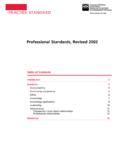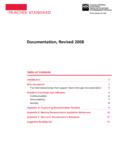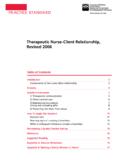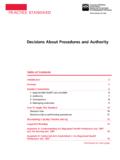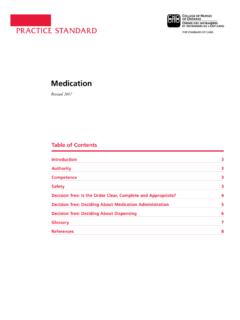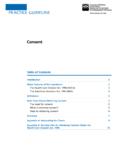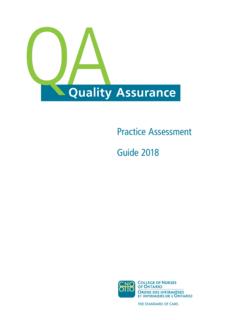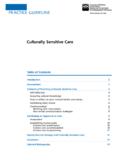Transcription of PRACTICE STANDARD Professional Standards, Revised 2002
1 PRACTICE STANDARDT able of Contents Introduction 3 standards 4 Accountability 4 Continuing competence 5 Ethics 6 Knowledge 7 Knowledge application 8 Leadership 10 Relationships 11 Therapeutic nurse-client relationships 11 Professional relationships 12 References 13 Professional standards , Revised 2002 Professional standards , Revised 2002 Pub.
2 No. 41006 ISBN 1-894557-33-6 Copyright College of Nurses of Ontario, or for-profit redistribution of this document in part or in whole is prohibited except with the written consent of CNO. This document may be reproduced in part or in whole for personal or educational use without permission, provided that: Due diligence is exercised in ensuring the accuracy of the materials reproduced; CNO is identified as the source; and The reproduction is not represented as an official version of the materials reproduced, nor as having been made in affiliation with, or with the endorsement of, published June 1996 as Professional standards Reprinted January 2000, October 2000 Revised June 2002, Reprinted December 2002, January 2004, December 2005, May 2008.
3 Updated June 2009. Aug 2013. May 2015 example removed copies of this document may be obtained by contacting CNO s Customer Service Centre at 416 928-0900 or toll-free in Ontario at 1 800 of Nurses of Ontario 101 Davenport , ON M5R fascicule existe en fran ais sous le titre : Normes professionnelles ( d. r vis e 2002), no 51006 OUR MISSION is to protect the public s right to quality nursing services by providing leadership to the nursing profession in VISION is excellence in nursing PRACTICE everywhere in STANDARD3 College of Nurses of Ontario PRACTICE STANDARD : Professional standards , Revised 2002 Nursing standards are expectations that contribute to public protection.
4 They inform nurses of their accountabilities and the public of what to expect of nurses. standards apply to all nurses regardless of their role, job description or area of PRACTICE . College of Nurses of OntarioIntroductionProfessional standards , Revised 2002 ( Professional standards ) provides an overall framework for the PRACTICE of nursing and a link with other standards , guidelines and competencies developed by the College of Nurses of Ontario (CNO). It describes in broad terms the Professional expectations of nurses1 and applies to all nurses, in every area of PRACTICE . Professional standards includes seven broad STANDARD statements, a description of each statement and indicators that illustrate how the STANDARD may be demonstrated.
5 To help nurses in different PRACTICE areas apply the standards , there are indicators for all nurses and for those in administrative, educational and research positions. As well, three of the standards (Knowledge, Knowledge application and Leadership) have indicators for RNs and NPs. The indicators used in this document are not a complete list, nor do they apply to all nurses at all times. As well, the seven standards are inter-related; an indicator used to illustrate one STANDARD may also demonstrate the application of other standards . How a nurse demonstrates a STANDARD is influenced by the nurse s level of competence, role, PRACTICE setting and the situation.
6 It is expected that all nurses will meet the expectations of these Professional standards and be able to articulate how they demonstrate the standards in their PRACTICE . Guiding principlesThe following principles guided the development of Professional standards : in Ontario, nursing is one profession with two categories RN (which includes NPs) and RPN; the foundational knowledge base of RNs and RPNs is different because of differences in basic nursing education; all nurses are accountable for their own decisions and actions and for maintaining competence throughout their career; clients2 are the central focus of the Professional services that nurses provide and as partners in the decision-making process, clients ultimately make their own decisions.
7 The goal of Professional practice3 is to obtain the best possible outcome for clients, with no unnecessary exposure to risk of harm; and all nurses continually enhance their knowledge through education, experience and self-assessment. Nurses can become experts in an area of PRACTICE within their STANDARD is an authoritative statement that sets out the legal and Professional basis of nursing PRACTICE . All standards of PRACTICE provide a guide to the knowledge, skills, judgment and attitudes that are needed to practise safely. They describe what each nurse is accountable and responsible for in PRACTICE . standards represent performance criteria for nurses and can interpret nursing s scope of PRACTICE to the public and other health care professionals.
8 standards can be used to stimulate peer feedback, encourage research to validate PRACTICE and generate research questions that lead to improvement in health care delivery. Finally, standards aid in developing a better understanding and respect for the various and complementary roles that nurses In this document, nurse refers to a Registered Practical Nurse (RPN), Registered Nurse (RN) and Nurse Practitioner (NP). 2 A client is a person with whom the nurse is engaged in a therapeutic relationship. In most circumstances, the client is an individual but the client may also include family members and/or substitute decision-makers. The client can also be a group ( , therapy), community ( , public health) or population ( , children with diabetes).
9 3 In this document Professional PRACTICE is defined as the care and/or services that nurses provide to clients. Care/services is the process of working with clients to identify care needs, and to establish, implement and continually evaluate plans of STANDARD4 College of Nurses of Ontario PRACTICE STANDARD : Professional standards , Revised 2002 StandardsThe seven standards are presented in alphabetical order. All standards have equal importance and are nurse is accountable to the public and responsible for ensuring that her/his PRACTICE and conduct meets legislative requirements and the standards of the profession. Nurses are responsible for their actions and the consequences of those actions.
10 They re also accountable for conducting themselves in ways that promote respect for the profession. Nurses are not accountable for the decisions or actions of other care providers when there was no way of knowing about those nurse demonstrates the STANDARD by: identifying her/himself and explaining her/his role to clients; providing, facilitating, advocating and promoting the best possible care for clients; advocating on behalf of clients; seeking assistance appropriately and in a timely manner; sharing nursing knowledge and expertise with others to meet client needs; ensuring PRACTICE is consistent with CNO s standards of PRACTICE and guidelines as well as legislation.

